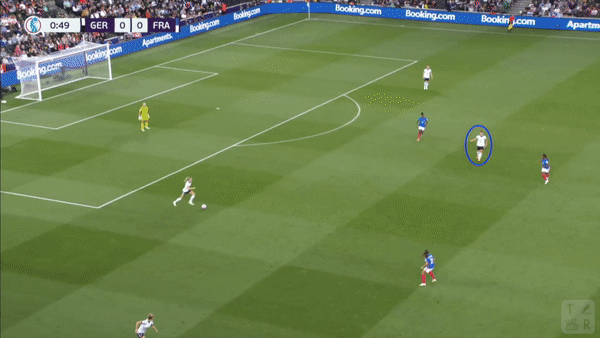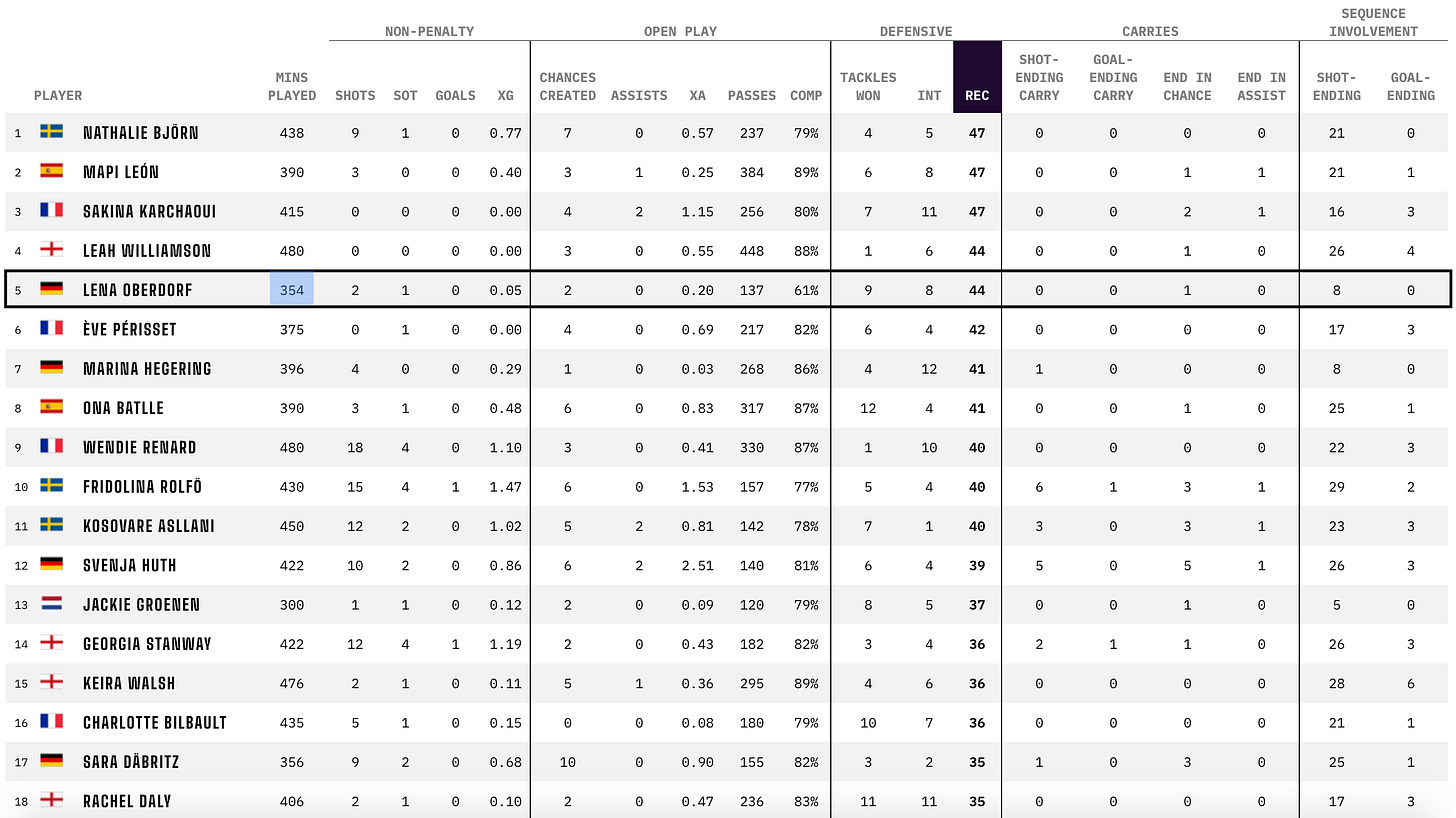How Lena Oberdorf Empowers Germany to Pass Without Fear
The 20-year-old's all-time defense completely changes the typical risk-reward calculus for possession play.
I currently keep all of my women’s football content free. Consider subscribing so I can continue to do so and to gain access to the full archive, where you can read paywalled articles on the men’s Champions League final, N’Golo Kanté’s underrated offense, and the evolution of defensive compactness.
I am running a forever-lasting discount for the duration of the EUROs (ends August 1st):
Is deliberate possession an offensive or defensive tool?
Trick question — the answer is both.
However, too often, people ignore the latter purpose. When Pep Guardiola asks his team to settle the tempo and play a series of short passes before progressing, the point isn’t just to emulate some broader Cruyffian ideal, but to minimize risk and create a strong defensive structure before the ball is even lost.
In this vein, proponents of Guardiola’s positional play model might argue that the faster you move the ball forward, the faster it returns to you, implying that overly-direct or -quick distribution will engender a chaotic, undesirable game environment.
The logic generally seems to pan out. For example, sides from the Red Bull system have typically had to contend with the limiting trade-offs that arise from manufacturing as much transition as possible. Not to sound like the Joker, but chaos is the great equalizer due to how much variance it introduces, which is why it’s difficult to consistently come out of frenzied settings as the victor.
Even the heavy metal, gegenpressing king, Jürgen Klopp, has had to somewhat concede his position on the matter, slowly reorienting Liverpool towards more ball dominance and control, as evidenced by the signing of Thiago, although The Reds still remain distinct in style from the likes of Manchester City.
Germany Women, on the other hand, have not budged from their high-octane convictions in EURO 2022 and have yet to face the “consequences,” making it all the way to the final after defeating the quality of Spain and France. Die Nationalelf rank highly in sequences with 10+ passes and “build ups” per The Analyst, but they still remain far off Spain and England (the former of whom has played one less game).

The data hints that Germany are only as patient and deliberate as the context requires (i.e. being the better team will see them have more of the ball) — when they can, they prefer to get into the final third as rapidly as possible. This notion is strongly supported on film; besides Sara Däbritz, very few of Germany’s front five offer to the ball, with Lina Magull preferring to position herself well inside the opposition block or against the last line.
These positional features prompt Germany into playing speculative passes into the channels or flighted balls into target woman Alexandra Popp, who tends to get support for the second duel from Magull and co. Coach Martina Voss-Tecklenburg also encourages pacy wing combinations that take advantage of the positioning and dynamism of her aggressive interiors.
All of this makes for exciting offense but seems like the perfect recipe for proceedings spinning out of control. While Germany mitigate some of the drawbacks with a ferocious counterpress, this can sometimes contribute to even more back-and-forth football, as they use their proactive defensive strategy to generate attacking opportunities rather than retain possession.
So, how have Germany managed to concede only one goal en route to the final? The answer: defensive midfielder Lena Oberdorf.
The 20-year-old is the type of rare talent that can dominate entire sequences all by herself. Take the opening seconds of Germany’s EURO 2022 campaign, where she was instantly called into action as a result of her side’s (and her own) direct attitude:
As bodies fight for the ball in the final third, Oberdorf uses her time away from the play to take stock of her surroundings, noticing two Denmark attackers either side of her. This gives her the intel she needs to quickly make a decision on who she should mark when Germany lose out and Denmark come the other way.
What’s striking is how quickly Oberdorf reengages for the second challenge, rushing over to smother a potential combination, before tracking back to cut out a cross and stop the same player from making an impact for the third time in a row.
Oberdorf’s constant scanning and lightning reaction time are key to fostering the impression that she is everywhere. She never switches off and has the processing speeds, inherent tactical understanding, and mental agility to track multiple threats and determine which one is most dangerous. Of course, it helps that she possesses the physical tools to swallow yardage with long strides and bully people into giving her their lunch money.
If Oberdorf has more than a second to map out what is happening, regaining possession is mere child’s play for her.
With Wolfsburg’s young star in the lineup, Germany don’t have to engage in the same risk-reward calculus that other sides do; there is less fear that accompanies every offensive action, emboldening players to thread tighter windows and press more aggressively. If someone messes up, no problem — Oberdorf will clean it up and Germany can start again.
This, in turn, puts immense stress on opposition defenses, who not only have to worry about stopping deliveries and combinations that other teams might never attempt, but find a way to progress or retain after winning the ball back. The latter conundrum has proved to be a massive problem for teams — Oberdorf secures the base of a counterpress that has, on average, allowed Germany to start possessions higher up the pitch than any other side in the tournament.

Nonetheless, Oberdorf is ready to save the day at any height and stage of build-up, especially when Germany attempt to develop through the wings, liberating her teammates to try difficult one-touch passes or ambitious balls.
In dynamic defensive situations, such as those in the above clips, Oberdorf marks “danger” rather than any particular player, which necessitates an incredibly intuitive grasp of context. She is always subconsciously computing the relationship between any outlet and the most threatening space for the passer, thereby enabling her to close down multiple people within the same sequence.
To the untrained eye, it looks like she’s chasing after the ball; in reality, Oberdorf is producing a zone of control that essentially brings the ball to her vicinity — in other words, her positioning makes all potential receiving options accessible to her.
Hence, it’s no surprise that she ranks in the top five for total recoveries in the tournament, with a superior minute ratio to all those ahead of her.
England present perhaps the biggest challenge for Voss-Tecklenburg’s side in EURO 2022 (and vice-versa), given that the hosts thrived at Germany’s preferred tempo and intensity vs. Sweden. If the eight-time champions are to continue to embrace the chaos and emerge triumphant in light of this, Lena Oberdorf will need to step up one more time and deliver another masterclass in defensive transition.
And who would bet against her?
There is a wealth of Oberdorf content at the moment:











